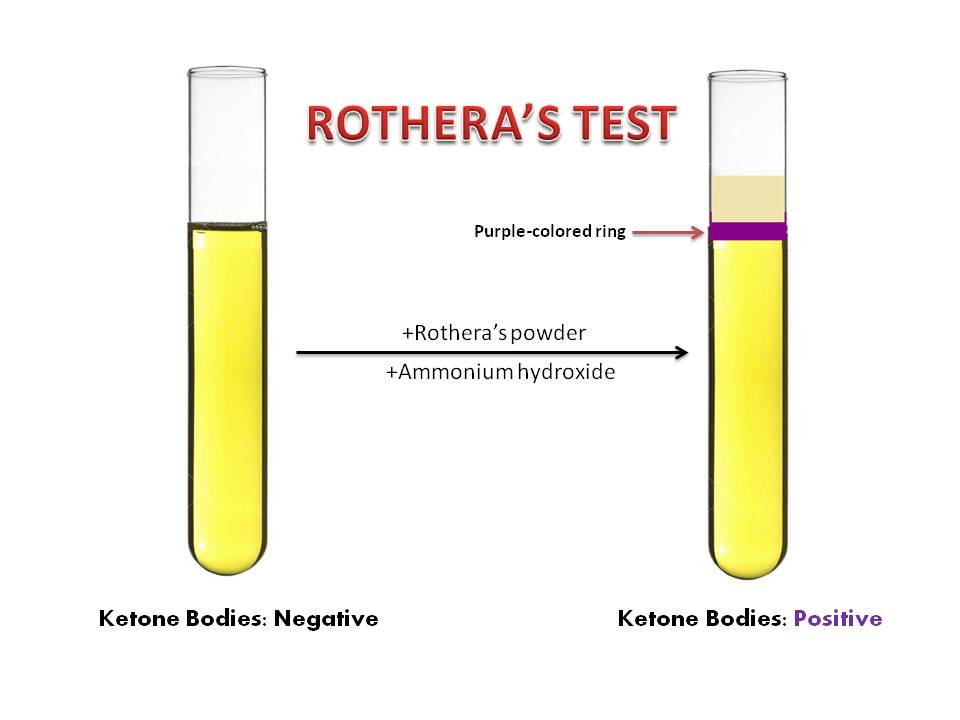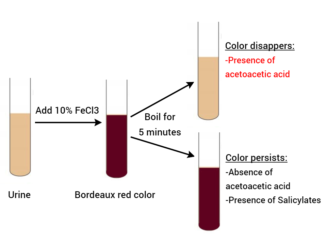The term ketone bodies refers to three intermediate products of fat metabolism, namely acetone (2%), acetoacetic acid (20%) and beta-hydroxybutyrate (78%). Under normal conditions, metabolized fats are completely broken down to water and carbon dioxide, hence negligible amount (1mg/24 hrs) of ketone bodies are excreted in urine.
When the rate of production exceeds, excess ketone bodies are eliminated in urine and the condition is known as ketonuria. Two conditions most commonly associated are starvation and Diabetes mellitus. Ketonuria is also seen in case of prolonged vomiting, severe diarrhoea, anesthesia, liver damage, high fat intake and low carbohydrate intake.
Various methods are available for detecting ketones in urine:
When the rate of production exceeds, excess ketone bodies are eliminated in urine and the condition is known as ketonuria. Two conditions most commonly associated are starvation and Diabetes mellitus. Ketonuria is also seen in case of prolonged vomiting, severe diarrhoea, anesthesia, liver damage, high fat intake and low carbohydrate intake.
Various methods are available for detecting ketones in urine:
- Rothera’s test
- Gerhardt’s test
- Lang’s test
- Lindeman’s test
- Han’s test
- Tablet test
Principle of Rothera’s Test
Acetoacetic acid and acetone react with alkaline solution of sodium nitroprusside to form a purple colored complex. This method can detect above 1-5 mg/dl of acetoacetic acid and 10-20 mg/dl of acetone. Beta-hydroxybutyrate is not detected.
Requirements
- Urine specimen
- Test tubes
- Rothera’s powder:
Sodium nitroprusside = 0.75 gm
Ammonium sulphate = 20gm
Mix and pulverize. - Liquor ammonia (Ammonium hydroxide)
Procedure of Rothera’s Test
- Transfer about 5 ml of urine to a test tube.
- Add 1 gm of Rothera’s powder mixture and mix well.
- Layer over the urine 1-2 ml of concentrated ammonium hydroxide.
- Observe the pink-purple ring at the interface.

Observations and Results
- Immediate formation of purple permanganate colored ring at the interface: Ketone bodies present (Positive)
- No formation of purple permanganate colored ring at the interface: ketone bodies absent (Negative)
Grade the result according to intensity of the formation of colored ring as Trace, +, ++, +++ or ++++.


Purple colour ring scientific name??
Why beta hydroxy butyric acid is not detected in this test?
Acetoacetate and acetone are true ketones, while β-hydroxybutyrate does not possess a keto group. As keto group is involved in Rothera’s test, it is not answered by β-hydroxybutyrate.
Beta hydroxy butyrate lacks keto group
What should be observed when performing rothera’s test?